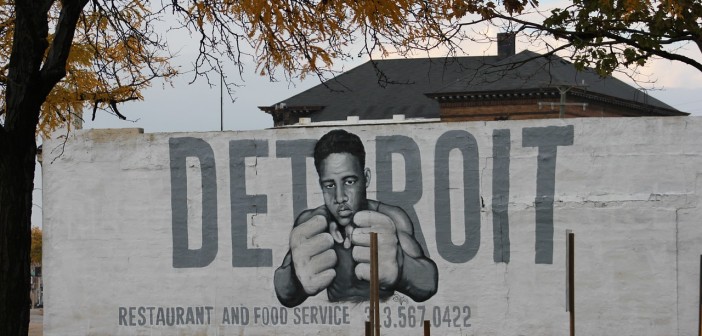Detroit is almost surgically separated into east and west by Woodward Avenue. Woodward stretches northwest from the Detroit River downtown all the way up through the suburbs until it dead-ends in Pontiac. Both sides of Detroit have been plagued with church closings during the last 40 years. Some of the congregations have merged and others have moved, but far too many have simply ceased to exist. The buildings are sold or sit empty. This is not to say that all the churches in Detroit have disappeared. There are a good number of vital ministries, including hundreds of storefront churches and a handful of thriving cathedrals, but church closings have played a part in the deterioration of the neighborhoods. Like removing tent stakes from the ground, without an adequate number of the anchors, a canvas structure or a local community collapses in on itself.
Richard created a sanctuary for a couple hundred mentally ill men and women, and he nurtured their community. He didn’t have a diploma, a robe, or a church building, but his love was as unwavering as the green button on his shirt.
Sixty United Methodist city churches are gone. St. Mark’s was eliminated in 1972, but unlike the closed churches, Richard wouldn’t let it die. Who was Richard? An experienced clergy person? A lifetime pillar member? A wealthy benefactor? A community organizer? An area activist? No, Richard Kwiatkowski was the custodian at the east side church.
Because he was the janitor, many were tempted to dismiss him. Without exception, Richard wore a military-style buzz cut, horn-rimmed glasses, and a pressed button-down shirt with cigarettes in the chest pocket. He generally rolled up his sleeves, exposing a Timex watch, and his shirt was always decorated with a green “Jesus Loves You” button. Richard was apt to give you a big bear hug, even if you were meeting him for the first time.
Congruent. That’s what I call people like Richard. They are the same inside and outside, identical with poor folks and affluent people. What you see is who they are all the time. Richard began befriending the men and women who started coming to St. Mark’s during the week. They lived in the adult foster care (AFC) homes surrounding the steepled church. Some were put out during the day and others voluntarily escaped. The problem was they had nowhere to go. They tended to be ignored or ridiculed and abused in the neighborhood. They were victims of crime and violence, so St. Mark’s allowed them to come in, and Richard offered them radical hospitality.
When St. Mark’s closed its doors, Richard scrambled to find an alternative site for the weekday people. For about a year they shifted to the YMCA. Then, Richard convinced the United Methodist bishop to sell him the associate pastor’s parsonage from St. Mark’s for a dollar, so it could be used as a drop-in center. The two-story house became a safe haven where adults from AFC homes enjoyed donuts, coffee with way too much sugar, and cigarettes. They met there to assemble puzzles, watch television, to play cards and bingo. Five days a week, they came to the building to eat lunch and receive toiletries. A couple of hundred participants would cram themselves into the downstairs living quarters for holiday parties.
East Side Ministries, as it became known, wasn’t a church in the conventional sense. There wasn’t a pulpit. There weren’t any pews or hymnals or stained glass windows. God knows Richard never preached or took up a collection. In fact, he was always giving things away — food, clothes, magazines, bus tickets, hygiene products. When burglars constantly broke in to pilfer things, he would complain only that there was no need to steal because things were free for the taking. When Jesus told his disciples that they should surrender their coats if someone asked for their shirt and that they should walk a second mile, Richard took him literally.
The people at East Side didn’t look like churchgoers either. They didn’t arrive in “church clothes.” They came casual and comfortable. Some were clad in tattered things, and a few wore three or four layers of clothing, even in the summer. These people never came by car. They walked the blocks between their group homes and East Side. They didn’t worry about holding offices or nursing grudges the way that some people do in traditional churches.
Still, Richard rescued the mission of St. Mark’s. He recognized that the people were at risk on the streets. The stores and restaurants threw them out like bags of garbage. Hoodlums physically attacked them for no particular reason. Crooks robbed them of what little they possessed. Richard created a sanctuary for a couple hundred mentally ill men and women, and he nurtured their community. To be sure, there were disruptive days when someone lashed out due to paranoia, irritation, depression, hallucinations. Occasionally someone heard voices or suffered the side effects of their medication. But mainly they enjoyed a safe place to belong. The people called him Rev. Richard. He didn’t have a diploma, a robe, or a church building, but it was not lost on the people that his love was as unwavering as the green button on his shirt.
This article is excerpted from her book This Far by Faith: Twenty Years at Cass Community (Cass Community Publishing House, 2014). It is available from the publisher as well as Cokesbury and Amazon.
Related Resources:
- A Love Letter to a Closed Church by Roger Lovette
- Leading a Ministry with Homeless People by Rudy Rasmus
- Your Community is Your Congregation by Joe Daniels
- Fast Forwarding Your Church’s Community Engagement by Reggie McNeal






